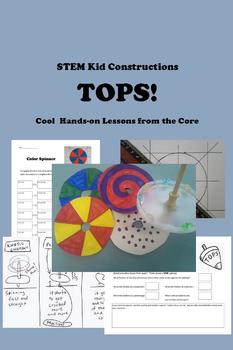STEM Kid Constructions - TOPS! Cool Lessons from the Core
Portable Gifted and Talented
3.1k Followers
Grade Levels
3rd - 7th
Subjects
Resource Type
Standards
CCSS4.MD.A.2
CCSS4.MD.C.6
CCSS5.MD.A.1
CCSS4.OA.A.3
CCSS5.NF.B.3
Formats Included
- Word Document File
Pages
37 pages
Portable Gifted and Talented
3.1k Followers
Also included in
- Let’s get ready for the second semester, you rock star gifted and talented teacher, you . . .By now the students can’t wait for their next group with you, so let’s not disappoint!Priced at more than 44% off individual purchases, I put this collection together with several things in mind:1. Best pracPrice $22.99Original Price $44.93Save $21.94
- None of these adventures appear in the STEAM CLASS CURRICULUM collection--a great supplement to your class at more than 33% off individual unit prices.Your kids will love these (part 1 of 2)! Tons of hands-on challenge and full of critical thinking—these eight units are heavily engineering and builPrice $16.99Original Price $22.47Save $5.48
Description
Tops are the tops! Let’s make our own and experiment!
Who would have thought we could blend so much science, engineering, and math into this simple little toy?
You’ve probably seen those valentines where you can punch out a circle and insert a pencil to make a top. Those are hugely disappointing. These tops, however, are COOL!
Anytime we do something cool in the classroom, we want to sneak in plenty of content with it, right? Such is the case here, and you’ll find Common Core State Standards and Next Generation Science Standards embedded in these lessons. Just look at all the activities:
Engineering: Constructing the top, drafting with tools and precision, mechanical drawing—circles, tangents, center points, diagonals, measuring angles.
Real-World Math Applications and Geometry: Probability, circumference, uncommon measurement, rpm.
Physics/Physical Science: Equilibrium, colors, axis, friction, kinetic and potential energy, precession, rpm.
Kid Biophysics: Perception and optical illusions.
These tops won’t break your piggy bank, either. They require only a plastic lid, some glue, construction paper, and a few wooden pieces you can find at any hobby store.
You’ll get written and photo instructions about how to make the top; ready-to-print math activities which examine rpm, probability, uncommon measurement, and color combinations; and notes and explanations with discussion questions on physics topics and optical illusions.
I’ve used this with my 5th grade gifted class, but it should be appropriate for 3rd grade GATE students through 6th grades.
It will take about an hour of class time to construct the tops, and several more hours more for the activities—depending on what you choose to do.
Who would have thought we could blend so much science, engineering, and math into this simple little toy?
You’ve probably seen those valentines where you can punch out a circle and insert a pencil to make a top. Those are hugely disappointing. These tops, however, are COOL!
Anytime we do something cool in the classroom, we want to sneak in plenty of content with it, right? Such is the case here, and you’ll find Common Core State Standards and Next Generation Science Standards embedded in these lessons. Just look at all the activities:
Engineering: Constructing the top, drafting with tools and precision, mechanical drawing—circles, tangents, center points, diagonals, measuring angles.
Real-World Math Applications and Geometry: Probability, circumference, uncommon measurement, rpm.
Physics/Physical Science: Equilibrium, colors, axis, friction, kinetic and potential energy, precession, rpm.
Kid Biophysics: Perception and optical illusions.
These tops won’t break your piggy bank, either. They require only a plastic lid, some glue, construction paper, and a few wooden pieces you can find at any hobby store.
You’ll get written and photo instructions about how to make the top; ready-to-print math activities which examine rpm, probability, uncommon measurement, and color combinations; and notes and explanations with discussion questions on physics topics and optical illusions.
I’ve used this with my 5th grade gifted class, but it should be appropriate for 3rd grade GATE students through 6th grades.
It will take about an hour of class time to construct the tops, and several more hours more for the activities—depending on what you choose to do.
Total Pages
37 pages
Answer Key
Included
Teaching Duration
Other
Report this resource to TPT
Reported resources will be reviewed by our team. Report this resource to let us know if this resource violates TPT’s content guidelines.
Standards
to see state-specific standards (only available in the US).
CCSS4.MD.A.2
Use the four operations to solve word problems involving distances, intervals of time, liquid volumes, masses of objects, and money, including problems involving simple fractions or decimals, and problems that require expressing measurements given in a larger unit in terms of a smaller unit. Represent measurement quantities using diagrams such as number line diagrams that feature a measurement scale.
CCSS4.MD.C.6
Measure angles in whole-number degrees using a protractor. Sketch angles of specified measure.
CCSS5.MD.A.1
Convert among different-sized standard measurement units within a given measurement system (e.g., convert 5 cm to 0.05 m), and use these conversions in solving multi-step, real world problems.
CCSS4.OA.A.3
Solve multistep word problems posed with whole numbers and having whole-number answers using the four operations, including problems in which remainders must be interpreted. Represent these problems using equations with a letter standing for the unknown quantity. Assess the reasonableness of answers using mental computation and estimation strategies including rounding.
CCSS5.NF.B.3
Interpret a fraction as division of the numerator by the denominator (𝘢/𝘣 = 𝘢 ÷ 𝘣). Solve word problems involving division of whole numbers leading to answers in the form of fractions or mixed numbers, e.g., by using visual fraction models or equations to represent the problem. For example, interpret 3/4 as the result of dividing 3 by 4, noting that 3/4 multiplied by 4 equals 3, and that when 3 wholes are shared equally among 4 people each person has a share of size 3/4. If 9 people want to share a 50-pound sack of rice equally by weight, how many pounds of rice should each person get? Between what two whole numbers does your answer lie?




